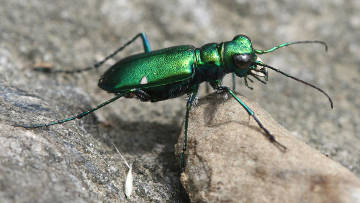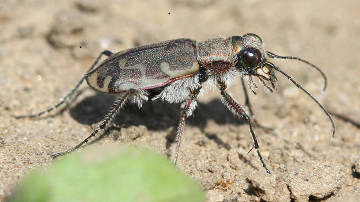

PHOTO COURTESY OF GARRY KESSLER
The iridescent green color of this six-spotted tiger beetle is likely to catch your eye on a trail in town. This tiger beetle is named for its small white spots, even though it doesn’t always have six of them.
September 20, 2013, Page A5
NATURE NOTES
By Annie Reid
Westborough Community Land Trust
Spot tiger beetles on Westborough trails
Westborough doesn’t have tigers, except on TV and online, but the human imagination has dubbed various native insects as one sort of “tiger” or another, including tiger beetles.
Most of us have never seen or heard of tiger beetles, but we’ve probably seen some of the other insects labeled as tigers. Tiger swallowtail butterflies, which are beautiful large yellow and black-striped butterflies, are summer favorites that flutter among the trees and flowers. Tiger moths include the plain-looking Isabella tiger moths into which autumn’s fuzzy orange and black woolly bear caterpillars turn.
But beetles are all around us. There are more species of beetles (order Coleoptera) than any other kind of insect – at least 345,000 species, with more than 30,000 in the U.S. and Canada. Some beetles that are quite familiar to us don’t have “beetle” in their name. For example, ladybugs are beetles (family Coccinellidae), and so are fireflies (family Lampyridae). And then there are the beetles many of us have heard of, such as the invasive garden pest known as Japanese beetles; the recent invader that threatens our maples, the Asian long-horned beetle; and the small, delicate Galerucella biocontrol beetles that feed on purple loosestrife.
You might spot a tiger beetle (subfamily Cicindelinae) while walking the trails in town. These beetles are about one-half to three-quarters of an inch long, with six long legs, large eyes, antennae that sense movement, and jaws made for chewing. They have two pairs of wings, but these aren’t obvious because they’re folded over the beetle’s back when not in use, with the hardened front wings covering the membrane-like back wings. Beetles are in an insect group that is aptly named Coleoptera, meaning “sheath wings.” Our area, the northeastern U.S., has about 20 species of tiger beetles.

PHOTO COURTESY OF GARRY KESSLER
Tiger beetles, such as this common shore tiger beetle, are about one-half to three-quarters of an inch long, with six long legs, large eyes, antennae that sense movement, and jaws made for chewing. Their two pairs of wings aren’t obvious because they’re folded over the beetle’s back when not in use, with the hardened front wings covering the membrane-like back wings.
If you walk with your eyes on the trail several feet ahead of you, as most of us routinely do, you’re well set up to see a tiger beetle. They’re usually found in sunny places where the path is bare dirt or sandy. They tend to move ahead or rush off to the side when you approach.
What do tiger beetles eat? Like their namesake, they’re carnivorous, but meat for them means insects. They hunt and eat other insects, especially ants. Not surprisingly, they’re quick. They catch their prey by running – quickly – or flying. A tiger beetle will grab another insect in its mouth and kill it by banging it on the ground. Then the tiger beetle will drink the juices from the prey’s body and use its formidable jaws to chew on the insect prey’s body.
One tiger beetle that you might notice because of its flashy appearance is the six-spotted tiger beetle (Cicindela sexguttata). This beetle is bright iridescent green, with six small white spots (although some of these beetles have fewer spots). It’s a little slower than other tiger beetles.
Another common but drab tiger beetle that you might see on the trails is the common shore tiger beetle (Cicindela repanda), also called the bronzed tiger beetle. It is brown with tan markings.
Look for both of these beetles in late summer and also in the spring.
Even though they fly, tiger beetles spend a lot of time on or in the ground. It’s their home. Adult tiger beetles dig short, tunnel-like burrows in the ground. They hide there at night and take shelter there when the weather is too cold, too hot, or stormy.
Tiger beetles begin life as eggs laid in the soil. They hatch into grub-like immature forms known as larvae. These larvae already have jaws. Like the adults, they are carnivorous and live in burrows. They lurk with their head at the burrow entrance where they can snatch passing insects. When they’ve eaten and grown enough, the larvae go through a metamorphosis (much as butterflies do) that transforms them into a very different body – adult tiger beetles complete with long legs and wings.
Both the six spotted tiger beetle and the common shore tiger beetle live more than a year and overwinter in the ground.
Watching for tiger beetles may increase your awareness of the insect life around you, and maybe also of the ground that is home to many insects and other creatures. Insects are a wildly successful group, and we share the planet with an unbelievable number of them. Of the 1.8 million living species that humans have described, more than half – 1 million – are insect species. They’re very different from us, and they can be fascinating and amazing.
Date index
Month (September)
Common name index
Scientific name index
Category index